|
|

|
|
Author
|
Topic: Orbital Sciences Antares-Cygus Orb-1 CRS flight
|
Robert Pearlman
Editor Posts: 42988
From: Houston, TX
Registered: Nov 1999
|
 posted 12-09-2013 08:20 AM
posted 12-09-2013 08:20 AM
   
Orbital Sciences release ISS Commercial Resupply Services Mission (Orb-1) - Launch Date: Jan. 9, 2014
- Launch Site: Mid-Atlantic Regional Spaceport, Wallops Island
- Launch Window: 1:10-1:15 p.m. EST (1810-1815 GMT)
- Cygnus Arrival at ISS: Jan. 12, 2014
An Antares rocket carrying Orbital's Cygnus cargo logistics spacecraft is scheduled to lift off from Pad-0A at the Mid-Atlantic Regional Spaceport at Wallops Island, Virginia on Jan. 9, 2014. Antares will boost Cygnus to a target orbit of 210 km by 298 km, from which Cygnus will use its on-board thrusters to raise its orbit to rendezvous and berth with the International Space Station (ISS). Berthing with the ISS is scheduled to occur on Jan. 12, 2014. For this mission Cygnus will be carrying approximately 1459 kg (3,217 lbs.) of cargo to the ISS for NASA. The Orb-1 mission is the first of eight commercial cargo resupply missions to the ISS under the NASA Commercial Resupply Services (CRS) contract, under which Orbital is slated to deliver up to 20,000 kg of supplies to the station. 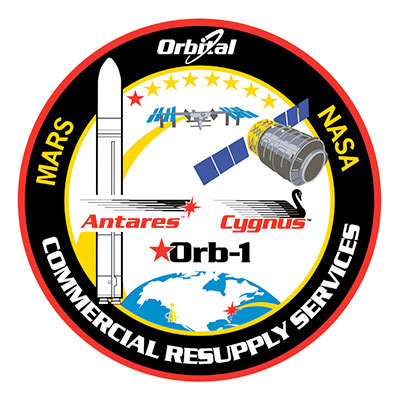 Antares Mission Description The two-stage Antares space launch vehicle utilizes a liquid-fueled first stage powered by two Aerojet Rocketdyne AJ26 engines and a solid motor ATK CASTOR 30B upper stage to boost Cygnus into orbit. The powered launch sequence will last about ten minutes from liftoff through the separation of Cygnus from the launch vehicle. Cygnus Mission Description After separation from Antares, Cygnus will deploy its solar arrays and undergo initial check-out. The spacecraft will conduct a series of thruster burns to raise its orbit to bring it within 4 km of the ISS prior to receiving authorization to autonomously rendezvous with the station. When the vehicle approaches to within 12 meters, the astronauts will use the station's robotic arm to grapple Cygnus and berth it to the Harmony node of the station. Cygnus is planned to remain berthed at the ISS for 42 days during which time the station crew will load Cygnus with materials for disposal. At the end of the mission Cygnus will depart the station and reenter the Earth's atmosphere. |
Robert Pearlman
Editor Posts: 42988
From: Houston, TX
Registered: Nov 1999
|
 posted 12-09-2013 08:26 AM
posted 12-09-2013 08:26 AM
   
collectSPACE Orbital names next space station freighter for late pilot-astronautThe next U.S. private spacecraft to fly to the International Space Station has been named for Gordon Fullerton, the late NASA astronaut who helped to deploy air-launched rockets built by the company behind the space freighter. Orbital Sciences Corp. is preparing to launch its second Cygnus unmanned spacecraft to the station Dec. 18 from the Mid-Atlantic Regional Spaceport at the NASA Wallops Flight Facility in Virginia. The flight will be the first of eight resupply missions the company will fly under a $1.9 billion contract with the space agency. 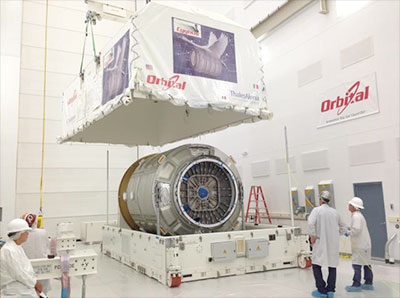 |
Robert Pearlman
Editor Posts: 42988
From: Houston, TX
Registered: Nov 1999
|
 posted 12-09-2013 10:56 AM
posted 12-09-2013 10:56 AM
   
Orbital Sciences release The Antares team continued making progress over the weekend toward the launch of Orbital's first CRS resupply mission next week, however ongoing pre-launch testing took a bit longer than expected which resulted in shifting the targeted launch date by one day to December 18. In the next several days, the Antares rocket will be installed on the transporter/erector/launcher vehicle and the Cygnus spacecraft will be mated with the upper stage of the rocket. The launch window on December 18 is from 9:42 to 9:47 p.m. (EST).
|
Robert Pearlman
Editor Posts: 42988
From: Houston, TX
Registered: Nov 1999
|
 posted 12-10-2013 05:26 PM
posted 12-10-2013 05:26 PM
   
Orbital Sciences release Orbital Prepares Antares and Cygnus for Upcoming Mission to the International Space StationToday (Dec. 10), Orbital Sciences Corporation continues to prepare for next week's launch at the Horizontal Integration Facility (HIF) on Wallops Island, Virginia. 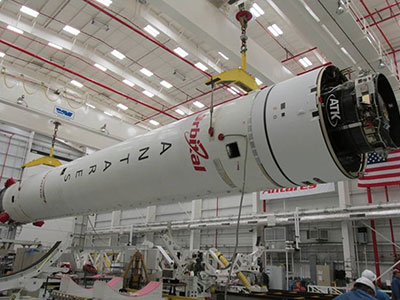 Yesterday, Antares was lifted onto the Transporter/Erector/Launcher (TEL). The TEL acts as a support structure as Antares is transported on the approximately one mile route from the HIF to Pad 0A. At the pad, hydraulic erection actuators rotate the TEL and the rocket to a vertical position, where the TEL functions as Antares' umbilical support structure. Later today, the Cygnus cargo spacecraft will be mated to the rocket. 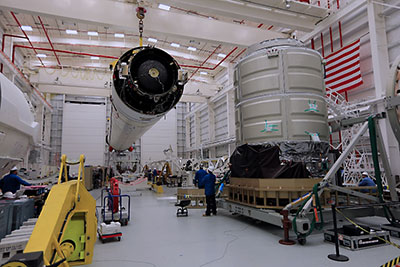 The majority of the cargo for the International Space Station is already loaded onto Cygnus. This week additional "late load" cargo will be installed in Cygnus, the hatch will be closed, and the cargo module will be pressurized prior to encapsulation in the 9.9 meter Antares payload fairing. Roll-out of Antares to the launch pad is currently scheduled for December 16. |
Robert Pearlman
Editor Posts: 42988
From: Houston, TX
Registered: Nov 1999
|
 posted 12-11-2013 01:35 PM
posted 12-11-2013 01:35 PM
   
Orbital Sciences release Overnight (Dec. 10-11), the operations team mated the Cygnus spacecraft to the Antares rocket that will launch it to the International Space Station. Later Wednesday, they will conduct "Flight Sim 2" which will simulate the complete launch sequence to ensure that the integrated Antares and Cygnus systems perform as designed. Post-test data analysis will follow immediately and will likely continue into Thursday. Next up is adding so called "late load" cargo into Cygnus, which includes, among others: - 33 cubesats that will be deployed from the space station at a later date;
- student experiments studying such areas as enzyme activity in microgravity, DNA mutation rate, cell regeneration and oil bubble formation;
- an experiment comparing differences in group behavior of ants living in microgravity conditions versus those living on Earth. Cameras will record the ants living on the space station and software will analyze their movement patterns and interaction rates. Students in K-12 will be able to observe the space station ants in near-real-time and conduct their own classroom experiments.
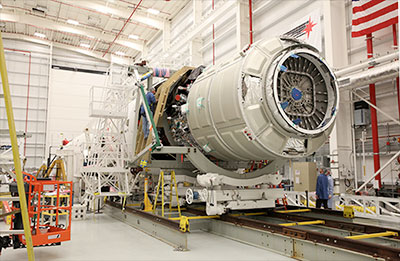
|
Robert Pearlman
Editor Posts: 42988
From: Houston, TX
Registered: Nov 1999
|
 posted 12-14-2013 10:51 AM
posted 12-14-2013 10:51 AM
   
Orbital Sciences release At NASA's direction, Orbital's operations team deferred loading the mission's final cargo into the Cygnus Saturday (Dec. 14), postponing that operation by a day. Orbital will await NASA's direction for the final cargo load tomorrow (Dec. 15) while the cooling loop issue aboard the International Space Station is being investigated. If Orbital gets the go-ahead to load the final, time sensitive cargo on Sunday, roll out to the pad would be on Tuesday (Dec. 17), launch on Dec. 19, and rendezvous and berthing on Dec. 22.
|
Robert Pearlman
Editor Posts: 42988
From: Houston, TX
Registered: Nov 1999
|
 posted 12-15-2013 01:45 PM
posted 12-15-2013 01:45 PM
   
NASA release Work is ongoing to either enable Orbital Sciences Corp. to launch its Antares rocket and the Cygnus cargo craft from the Wallops Flight Facility, Va. on Thursday night (Dec. 19) at 9:19 p.m. EST on its first resupply mission to the space station, or for space station astronauts to mount a suite of spacewalks to replace a faulty coolant pump. The space station program continues to keep both options on the table pending further engineering analysis and troubleshooting efforts on the station's cooling system. While the engineering work on the station's cooling loop continued, technicians at Wallops prepared to load time-critical science cargo in the Cygnus spacecraft Sunday afternoon to preserve several days of launch opportunities beginning Thursday night. The current schedule calls for the vehicle fairing to be installed on the Antares upper stage around Cygnus on Monday. The Antares rocket and attached Cygnus are scheduled to rollout to the launch pad at Wallops in the early hours on Tuesday.
|
Robert Pearlman
Editor Posts: 42988
From: Houston, TX
Registered: Nov 1999
|
 posted 12-17-2013 08:11 AM
posted 12-17-2013 08:11 AM
   
NASA photo release An Orbital Sciences Corporation Antares rocket is seen as it is rolled out to launch Pad-0A at NASA's Wallops Flight Facility, Tuesday, Dec. 16, 2013 in advance of a Thursday launch, Wallops Island, VA. The Antares will launch a Cygnus spacecraft on a cargo resupply mission to the International Space Station. The Orbital-1 mission is Orbital Sciences' first contracted cargo delivery flight to the space station for NASA. Launch is scheduled for 9:19 p.m. EST on Thursday, Dec. 19 (0219 GMT Dec. 20). Weather permitting, it may be widely visible along the east coast of the United States. Photos credit: NASA/Bill Ingalls
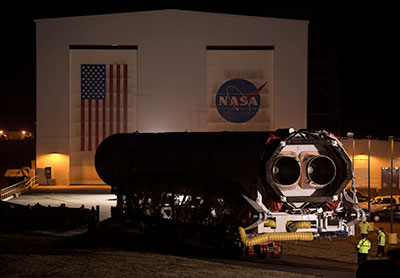 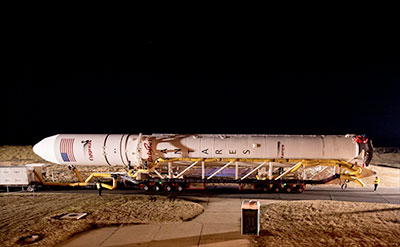
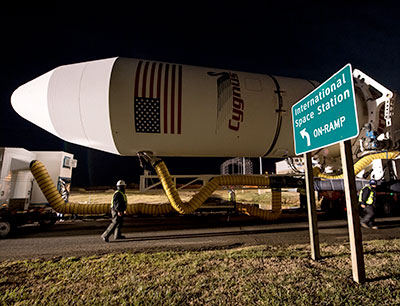
|
Robert Pearlman
Editor Posts: 42988
From: Houston, TX
Registered: Nov 1999
|
 posted 12-17-2013 11:16 AM
posted 12-17-2013 11:16 AM
   
NASA photo release The Orbital Sciences Corporation Antares rocket is seen being raised into position at launch Pad-0A, Tuesday, Dec. 17, at NASA's Wallops Flight Facility, Wallops Island, VA. Photos credit: NASA/Bill Ingalls
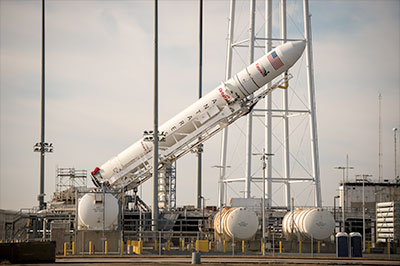 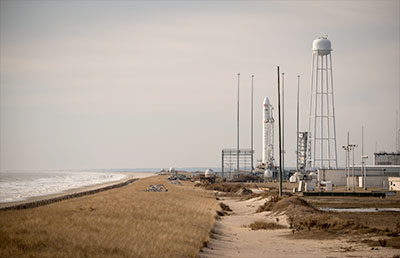
|
Robert Pearlman
Editor Posts: 42988
From: Houston, TX
Registered: Nov 1999
|
 posted 12-17-2013 05:02 PM
posted 12-17-2013 05:02 PM
   
Orbital Sciences Corporation release Cygnus resupply mission to the International Space Station postponedNext Launch Opportunity is No Earlier Than January 13 Today (Dec. 17), at NASA's direction, Orbital Sciences Corporation has postponed the launch of its commercial cargo resupply mission to the International Space Station (ISS) that was scheduled to occur on Dec. 19, 2013, while the space agency proceeds with a series of spacewalks to replace a faulty pump module on the ISS. The Antares rocket that is currently on the launch pad at Wallops Island, Va., will be returned to a horizontal position and transported back to the Horizontal Integration Facility (HIF). At the HIF, the Antares payload fairing will be removed to allow the Cygnus team to remove time-critical payloads for safekeeping until the next launch attempt, which will occur no earlier than Jan. 13, 2014. |
Robert Pearlman
Editor Posts: 42988
From: Houston, TX
Registered: Nov 1999
|
 posted 12-20-2013 04:32 PM
posted 12-20-2013 04:32 PM
   
Orbital Sciences Corporation release NASA and Orbital have established a new "no earlier than" (NET) launch date of Tuesday, Jan. 7, for the Orbital-1 CRS cargo resupply mission to the International Space Station from NASA's Wallops Flight Facility in eastern Virginia. A launch on Jan. 7 within the targeted window of 1:55 to 2:00 p.m. EST would result in a grapple and berthing at the space station in the early morning hours of Jan. 10. The launch date will continue to be evaluated as NASA proceeds with three upcoming spacewalks by the Expedition 38 crew to replace a cooling pump aboard the orbiting complex. Following the postponement of the originally targeted Dec. 19 launch, Orbital's Antares team rolled the rocket off the launch pad and back to the Horizontal Integration Facility on Dec. 19 at Wallops. The time sensitive payloads that were on Cygnus are being removed Friday (Dec. 20). They will be "refreshed" by the payload provider and returned for reloading into Cygnus. That operation would take place on Jan. 3. Rollout to the launch pad would occur on Jan. 4 to meet a Jan. 7 launch. A conflict with a previously scheduled operation on the Wallops range has been resolved to allow the Antares launch to be proceed earlier than was originally thought possible after the decision was made to postpone the Dec. 19 launch attempt.
|
Robert Pearlman
Editor Posts: 42988
From: Houston, TX
Registered: Nov 1999
|
 posted 01-03-2014 04:31 PM
posted 01-03-2014 04:31 PM
   
Orbital Sciences Corporation release Orbital Sciences Corp., in consultation with NASA, has decided to reschedule the Antares CRS Orb-1 Space Station Resupply Mission launch for no earlier than Wednesday, Jan. 8, 2014. The new target date was set due to the extreme cold temperatures that are forecast for early next week, coupled with likely precipitation events predicted for Sunday night and Monday morning. While Orbital is preserving the option to launch on Jan. 8, it is more likely that the launch will take place on Thursday, Jan. 9 because of a much improved weather forecast for later in the week. The launch window Wednesday is 1:32-1:37 p.m. EST (1832-1837 GMT). If weather conditions on Wednesday do not prove favorable, the window on Thursday (Jan. 9) is 1:10-1:15 p.m. EST (1810-1815 GMT). Rollout of the rocket to the pad will occur as previously scheduled tomorrow night, Jan. 4, due to the relatively favorable weather, and the fact that the cargo has already been loaded onto the Cygnus. The team will execute on-pad preparations (mating the rocket to the pad, rotating the rocket to its vertical position, connecting umbilicals, etc.) immediately after rollout. The Launch Readiness Review is currently scheduled to take place on Monday, Jan. 6.
|
Robert Pearlman
Editor Posts: 42988
From: Houston, TX
Registered: Nov 1999
|
 posted 01-05-2014 10:24 PM
posted 01-05-2014 10:24 PM
   
NASA photo release An Orbital Sciences Corporation Antares rocket is seen as it is rolled out to launch Pad-0A at NASA's Wallops Flight Facility, Sunday, Jan. 5, 2014, in advance of a planned Wednesday, Jan. 8, 1:32 p.m. EST (1832 GMT) launch, Wallops Island, VA. Photo credit: NASA/Bill Ingalls
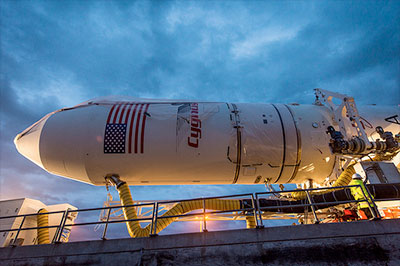 |
Robert Pearlman
Editor Posts: 42988
From: Houston, TX
Registered: Nov 1999
|
 posted 01-08-2014 06:09 AM
posted 01-08-2014 06:09 AM
   
collectSPACE Space weather scrub: Space station cargo delivery delayed by solar flareA massive flare eruption from the sun has scrubbed the planned Wednesday (Jan. 8) launch of a private cargo freighter to the International Space Station. The intense high-energy radiation rose from what appears to be one of the largest sunspot groups seen on the star's surface in a decade. Orbital Sciences Corporation had been planning to launch its Antares rocket, topped with a Cygnus spacecraft, from the Mid-Atlantic Regional Spaceport's Pad 0A at NASA's Wallops Flight Facility in Virginia. The Orb-1 mission was to lift off at 1:32 p.m. EST (1832 GMT), coincidentally the same time that the solar flare erupted Tuesday. "Early this morning, the Antares launch team decided to scrub [Wednesday's] launch attempt due to an unusually high level of space radiation," Orbital officials said. "[The proton-flux levels] exceeded by a considerable margin the constraints imposed on the mission to ensure the rocket's electronic systems are not impacted by a harsh radiation environment." |
Robert Pearlman
Editor Posts: 42988
From: Houston, TX
Registered: Nov 1999
|
 posted 01-08-2014 04:51 PM
posted 01-08-2014 04:51 PM
   
Orbital Sciences release Orbital to Proceed with Antares Launch ThursdayFollowing a comprehensive review of data related to the radiation environment in space, further reviews and modeling of the rocket's avionics systems, and the forecast for favorable terrestrial weather conditions at the Wallops Island launch facility, the Antares launch team has decided to proceed forward with a launch attempt of the Orbital-1 CRS mission to the International Space Station tomorrow, Thursday (Jan. 9). Upon a deeper examination of the current space weather, Orbital's engineering team, in consultation with NASA, has determined that the risk to launch success is within acceptable limits established at the outset of the Antares program. Tomorrow's target launch time is 1:07 p.m. EST (1807 GMT), which would allow the Cygnus spacecraft to rendezvous and berth with the International Space Station early Sunday morning, Jan. 12. |
Robert Pearlman
Editor Posts: 42988
From: Houston, TX
Registered: Nov 1999
|
 posted 01-09-2014 08:40 AM
posted 01-09-2014 08:40 AM
   
Orb-1 launch countdown underwayThe launch day countdown began at 4:07 a.m. EST (0907 GMT) Thursday (Jan. 9) as teams reported to stations in preparation for the launch of Orbital Sciences' Orbital-1 (Orb-1) cargo resupply mission to the International Space Station. Orbital is targeting a 1:07 p.m. EST (1807 GMT) launch from the Mid-Atlantic Regional Spaceport Pad 0A at NASA's Wallops Flight Facility in eastern Virginia. Launch is on track and the Orbital team is not working any issues. The weather has improved to an 85 percent chance of favorable conditions at the time of launch. Thick clouds are the primary concern for a weather violation. |
Robert Pearlman
Editor Posts: 42988
From: Houston, TX
Registered: Nov 1999
|
 posted 01-09-2014 12:27 PM
posted 01-09-2014 12:27 PM
   
collectSPACE Orbital Sciences launches Cygnus ship on first NASA cargo run to space stationA commercial space freighter packed with science experiments and crew supplies launched for the International Space Station on Thursday (Jan. 9), after being delayed three weeks by a string of unusual events. Orbital Sciences Corp.'s Antares rocket and Cygnus cargo ship lifted off at 1:07 p.m. EST (1807 GMT) from the Mid-Atlantic Regional Spaceport's Pad 0A at NASA's Wallops Flight Facility in Virginia. The unmanned spacecraft is now on its way to a Sunday morning (Jan. 12) rendezvous with the space station. 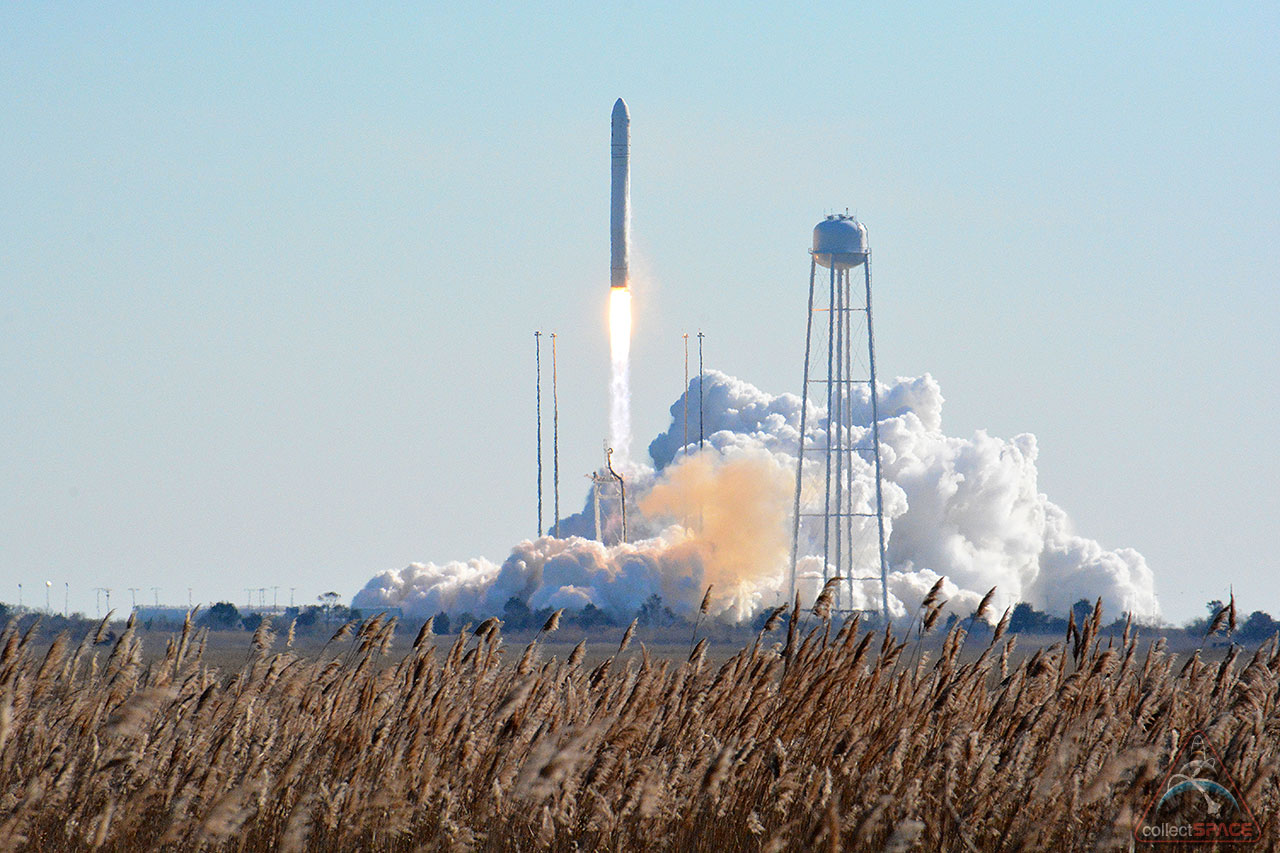 |
Robert Pearlman
Editor Posts: 42988
From: Houston, TX
Registered: Nov 1999
|
 posted 01-12-2014 05:18 AM
posted 01-12-2014 05:18 AM
   
Cygnus captured by space station robotic armISS Expedition 38 crew members Mike Hopkins and Koichi Wakata captured Orbital Sciences Corp.'s Cygnus cargo spacecraft using the International Space Station's robotic arm at 5:08 a.m. CST (1108 GMT) as the vehicles flew 260 statute miles (420 kilometers) over the Indian Ocean, northeast of Madagascar.
The Orb-1 "Spaceship C. Gordon Fullerton" will now be maneuvered by Wakata for berthing on the Earth-facing port of the space station's Harmony module. |
Robert Pearlman
Editor Posts: 42988
From: Houston, TX
Registered: Nov 1999
|
 posted 01-12-2014 07:17 AM
posted 01-12-2014 07:17 AM
   
Orbital Sciences release Orbital's Cygnus spacecraft successfully berths with International Space StationOrbital Sciences Corp. announced Sunday (Jan. 12) that its Cygnus cargo logistics spacecraft successfully completed its rendezvous and approach maneuvers with the International Space Station (ISS) and was grappled and berthed with the station by the Expedition 38 crew earlier this morning. After Cygnus was launched into orbit by Orbital's Antares rocket on Thursday, Jan. 9 from NASA's Wallops Flight Facility, it completed a series of thruster firings and other maneuvers bringing the spacecraft in close proximity to the ISS. Final approach to the station began at about 3:00 a.m. EST (0800 GMT) Sunday (Jan. 12), culminating with the station's robotic arm grappling the spacecraft at 6:08 a.m. EST (1108 GMT) when it was about 30 feet (10 meters) from the ISS. Cygnus was then guided to its berthing port on the nadir (Earth-facing) side of the ISS' Harmony module where its installation was completed at 8:05 a.m. EST (1305 GMT). "Our first mission under the CRS contract with NASA was flawlessly executed by our Antares and Cygnus operations team, from the picture-perfect launch from NASA's Wallops Flight Facility to the rendezvous, capture and berthing at the space station this morning," said Mr. David W. Thompson, Orbital's President and Chief Executive Officer. "From the men and women involved in the design, integration and test, to those who launched the Antares and operated the Cygnus, our whole team has performed at a very high level for our NASA customer and I am very proud of their extraordinary efforts." 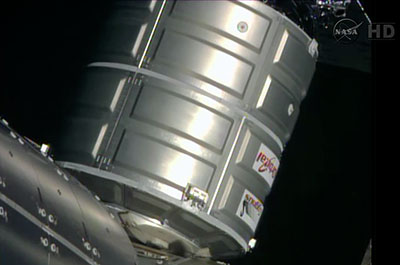 Cygnus will remain berthed at the ISS until February 18. Cygnus is delivering approximately 2,780 lbs. (1,260 kg.) of cargo and science payloads to the Expedition 38 astronauts. Either later today or tomorrow, the crew plans to open the Cygnus hatch and make initial ingress into its cargo module. Cygnus will remain attached to the station for 37 days before departing with approximately 2,800 lbs. (1,300 kg.) of disposable cargo for a safe, destructive reentry over the Pacific Ocean.
Under a $1.9 billion CRS contract with NASA, Orbital will use Antares and Cygnus to deliver up to 44,000 pounds (20,000 kilograms) of cargo to the ISS over eight missions, including the mission currently underway, through late 2016. For these missions, NASA will manifest a variety of essential items based on ISS program needs, including food, clothing, crew supplies, spare parts and equipment, and scientific experiments. |
Robert Pearlman
Editor Posts: 42988
From: Houston, TX
Registered: Nov 1999
|
 posted 02-18-2014 08:31 AM
posted 02-18-2014 08:31 AM
   
Orbital Sciences release Orbital's Cygnus spacecraft completes first space station resupply missionOrbital Sciences Corporation's Cygnus spacecraft, which delivered nearly one-and-a-half tons of supplies and scientific equipment to the International Space Station in January, completed its first commercial cargo mission to the orbiting laboratory Tuesday (Feb. 18). NASA astronaut Mike Hopkins, together with JAXA astronaut Koichi Wakata, used the station's 57-foot Canadarm2 robotic arm to detach Cygnus from the Earth-facing port of the Harmony node at 4:15 a.m. CST (1015 GMT). While Wakata monitored data and kept in contact with the team at Houston's Mission Control Center, Hopkins released Cygnus from the robotic arm at 5:41 a.m. CST (1141 GMT). 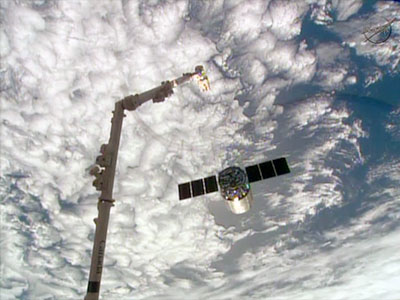 At the time of release, the station was orbiting about 260 miles (420 kilometers) over the southern Atlantic Ocean off the southeast coast of Argentina and Uruguay. From their vantage point inside the station's cupola observation deck, the two flight engineers monitored telemetry from Cygnus as the unpiloted resupply ship — now loaded with trash — made a 1-minute, 30-second departure burn to move a safe distance away from the station. The commercial cargo craft will begin its deorbit sequence shortly after 7 a.m. CST (1300 GMT) Wednesday to enable it to slip out of orbit for a destructive entry into Earth's atmosphere. Cygnus will burn up over the Pacific Ocean later that afternoon. During its first NASA-contracted mission, designated Orb-1, Cygnus delivered 2,780 pounds (1,260 kilograms) of supplies to the station, including vital science experiments for the Expedition 38 crew. |
Robert Pearlman
Editor Posts: 42988
From: Houston, TX
Registered: Nov 1999
|
 posted 02-19-2014 01:23 PM
posted 02-19-2014 01:23 PM
   
Orbital Sciences Corporation release Orbital Completes First Operational Cargo Mission to International Space Station for NASACygnus Cargo Logistics Spacecraft Reenters Earth's Atmosphere Over Pacific Ocean Orbital Sciences Corporation, one of the world's leading space technology companies, today announced the successful completion of the first of eight Cygnus operational cargo logistics spacecraft missions to the International Space Station (ISS) as part of the company's $1.9 billion Commercial Resupply Services (CRS) contract with NASA. The Cygnus spacecraft unberthed from the ISS Tuesday morning (Feb. 18) at 6:41 a.m. (EST), completing a 37-day stay at the orbiting laboratory. Wednesday, Cygnus reentered Earth's atmosphere over the Pacific Ocean east of New Zealand at approximately 1:20 p.m. (EST). "We are very proud to have a second flawless cargo mission to the space station brought to a successful conclusion this afternoon," said Mr. David W. Thompson, Orbital's Chairman and Chief Executive Officer. "Following Cygnus' successful demonstration mission in late 2013 conducted under our COTS research and development partnership with NASA, the picture-perfect execution of the first operational mission is a great way to start the CRS contract. We are looking forward to the next Antares launch and Cygnus cargo delivery mission currently scheduled for early May." The CRS-1 mission began on January 9, 2014 when Orbital's Antares rocket launched Cygnus into orbit from the Mid-Atlantic Regional Spaceport (MARS) located at NASA's Wallops Flight Facility in eastern Virginia. Cygnus, which carried 2,780 lbs. (1,260 kg.) of cargo and science payloads, rendezvoused and berthed with the ISS three days later on January 12. Prior to its departure from the station, the astronauts loaded the cargo module with approximately 3,250 lbs. (1,477 kg.) of unneeded items for disposal. Under the CRS contract with NASA, Orbital is using Antares and Cygnus to deliver up to 44,000 lbs. (20,000 kg.) of cargo to the ISS over eight missions, including the CRS-1 flight just completed, through late 2016. For these missions, NASA will manifest a variety of essential items based on ISS program needs, including food, clothing, crew supplies, spare parts and equipment, and scientific experiments. Preparations are already well advanced for the next Cygnus cargo delivery flight, the CRS-2 mission, scheduled to take place in early May. The Antares rocket for the mission is now undergoing final assembly at Wallops Island, while the Cygnus spacecraft is being prepared for shipment to the Wallops launch site in mid-March. The CRS-2 flight is expected to deliver about 3,630 lbs. (1,650 kg.) of cargo to the Space Station. See here for discussion of Orbital Sciences Antares-Cygus Orb-1 CRS flight. | |
Contact Us | The Source for Space History & Artifacts
Copyright 2020 collectSPACE.com All rights reserved.

Ultimate Bulletin Board 5.47a
|
|

|
 advertisement advertisement

|

























